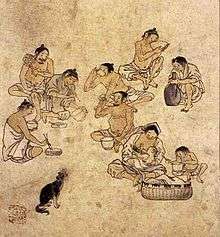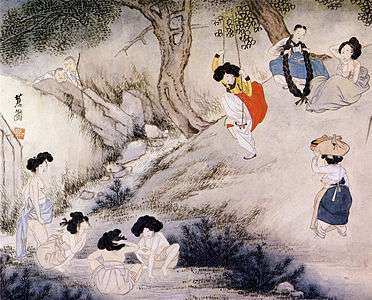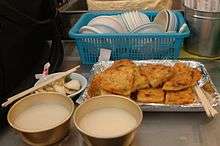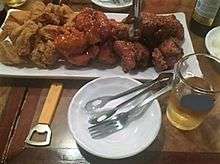Drinking culture of Korea
South Korea's drinking culture reveals much about its social structure, lifestyle, and traditions.[1] The beverages themselves are also reflective of the country's geography, climate, and cultures.
South Korea's interest in creating its own alcohol came about during the Koryo Dynasty (946–943), when exposure to foreign cultures and the introduction of distilled water created the basis and technique for distilling a unique alcohol.[2]
History of South Korean drinking culture
South Korea has a long tradition of consuming alcohol to celebrate holidays and seasonal events, in which they honor ancestors and exchange goodwill with neighbors and friends. Some of the holidays included New Year, Rice planting and South Korea's Day of Thanks.

Farming
Drinking alcohol is often correlated with a season's passing and its related farming activities. Once the harvest has ended farmers would spend their downtime brewing and fermenting alcohol as they looked forward to the spring.[3]
South Korean ancestors often drank a glass of rice-wine (Takju) accompanied by a light breakfast snack (Saecham) before they left for the fields in the morning. Traditional South Korean music (Nongak) would play while they worked.[4]
Korean New Year
Upon the new year Korean ancestors consumed Soju to drive out disease and bad spirits, the word 'Soju' meaning a welcoming spring. One type of Soju is called Dosoju, made with medicinal herbs and refined rice wine.[5]
Alcohol consumption was also used to medicate both adults and children during illnesses. Because alcohol was held in such high regard, Korean ancestors took great pains to pass down drinking customs from generation to generation.[6]
Daeboreum
The 15th day of the New Year according to the lunar calendar is a traditional South Korean holiday. Many attend moon-viewing events all over the country for the new year's first full moon. On that night, Koreans drink Daeboreium or "ear-quickening wine" in hopes of hearing good news quickly for the next year. While children do not drink the alcohol they are encouraged to place their lips to the glass, then pour the wine in a chimney to deter sickness and vaporization. Each region gave their own name to the beverage.[7]

Dano
The fifth day of the fifth month of the lunar calendar is called ‘Dano’. This is an important holiday and celebrates the transplanting of rice seedlings and the time of year when yin energy is weakest and yang energy is strongest.
The custom during ‘Dano’ was/is to hold a memorial service [8] for their ancestors and toast the day with a drink mixed with sweet flag called Changpoju. The properties in the drink were said to dispel evil spirits, providing escape from misfortune and promote health and longevity.[9]
During this era most Koreans practiced Confucianism which prohibited women and certain other members of society from drinking alcohol or pouring it for someone else. However, in modern times anyone can partake in the customs.
Alcohol drinking etiquette
Koreans have strict rules of etiquette in drinking alcoholic beverages. When receiving a glass from an elder, one must hold the glass with two hands (left palm at the bottom and hold the glass with the right hand) and bow the head slightly. When it is time to drink, the drinker must turn away from the elder, and cover the mouth and glass with their hands. The first drink must be finished in one shot. When the glass is empty, the drinker hands it back to the person who poured the drink for them and the drinker then pours them a shot. This starts a series of glass and bottle passes around the table.[10][11][12]
By the middle of 1300s, manners and culture of drinking came into South Korea. There are many manners about drinking alcohol in South Korea. Among them is a typical manner of drinking culture called 'Hyangeumjurye(향음주례)'. It was an event that saw many classical and Confucian scholars gather and drink, learning drinking manners. It also meant that people had to respect benevolent persons and support old men. It was held every October.[13]
Within 'Hyanguemjurye, the most important thing about South Korea drinking culture is manners. Koreans believed drinking etiquette is important. When people become of age to drink alcohol, they are taught how to drink with other people by elders, because Korean ancestors thought that pouring and receiving drinks was important over the bowl.
Pouring drinks
In South Korea, it is traditional that when a person gives an alcoholic drink to another adult, the person has to offer the drink respectfully with two hands. When pouring a drink, the bottle should be held with the right hand, and the wrist of your right hand held lightly with the left hand.(Where is the bottle?) It is customary to wait until the glass is empty to pour another.
Receiving drinks
There is also a tradition for receiving drinks. When receiving drinks, the same etiquette applies when pouring drinks. When elders give alcohol to a younger person, the younger person should receive the drink politely and with gratitude by saying "thank you". The next step is to hit the bottle, and then put it down. This pleases the elders. Also, when drinking beer, it is proper for the younger drinker to turn their head, so as to not directly face the elders when drinking.
Modern Korean drinking culture


As society developed, the drinking culture started to change. In the past, people drank on specific days like New Year's, but presently alcohol can be consumed regardless of the occasion. The goal of drinking parties is to promote good fellowship and open one's heart to talking. Some other aspects are beginning to adapt to modern ways as well; Koreans are changing to enjoy drinking all kinds of alcohol. They also like to make special cocktails like "bomb drink" or "poktanju". A "bomb drink" is a mixed drink similar to the American boilermaker—a whiskey shot sunk into a glass of beer. In Korea, many people like "poktanju". Examples are soju and (mekju) beer = Somek, foreign liquors and beers, and soju, beer and coke (kojingamlae). Poktanju makes people inebriated fairly quickly; nevertheless, people enjoy drinking it and drink it bottoms up.[14] There are many Poktanju, with many new ones becoming famous, including 'red eye' and 'meakkiss', and commonly mix alcohol with other liquids such as milk, tomato juice, coke and coffee.[15]
One of the most common forms of drinking is the hoesik, which literally means dinner with co-workers.[16] Many companies require their employees to join in frequent eating and drinking binges after work with bosses, although this trend has decreased in recent years, following backlash against excessive forced drinking, long hours, and sexual misconduct.[17]
It is common to match certain alcohols with certain foods, like soju to samgyeopsal, and makgeoli to jeon.

See also
- Chimaek
- Korean alcoholic beverages
References
- sanghee, lee (2009). Drinking: drinking culture of Korea #1(술: 한국의 술문화1). Seon. pp. 56–59.
- woochang, shin (2008-04-24). "[alcohol story] You need to restore the 'disappeared' Korea Pearl alcohol ([술이야기]외래 술에 사라진 '한국 명주' 복원해야)". Sport kyunghyang.
- Jongki, Lee (2009). Drinking story. Dahalmedia. ISBN 9788989988694.
- youngjune, choi (2004). understanding of alcohol(주류학의 이해). gimoonsa. p. 19.
- seosuck, yoon (2008). Cutom and festival of South Korea(한국의 풍속, 잔치). Ewha Womans University Press. pp. 105–106. ISBN 8973007769.
- sungnam, chu (2012-01-23). "drinking alcohol in Korean New Year(설날에 마시는 술...도소주)". MBN.
- seosuck, yoon (2008). Cutom and festival of South Korea(한국의 풍속, 잔치). Ewha Womans University Press. pp. 80–105. ISBN 8973007769.
- sagnhee, lee (2009). Drinking: drinking culture of Korea 1(술: 한국의 술문화1). sun. ISBN 8963120066.
- people who hold the nature (2013). South Korea's natural alcohol (한국의 자연약술). item books. pp. 186–187. ISBN 8987095975.
- Hines, Nick (7 March 2017). "Soju: Everything You Need to Know About Korea's National Drink". VinePair. Retrieved 16 May 2017.
- "How to Drink Soju Like the Koreans". Obsev. Retrieved December 14, 2015.
- "What is Soju ?". Alcoholic Science. Retrieved December 14, 2015.
- hakmin, kim (2012). There is alcohol in the beginning. Yellow Sea Writings. ISBN 9788974835071.
- health chosun (2013-06-10). "reason of drink poktanju". chosunas.
- yonggi, jeon (2013-05-22). "moving from soju poktanju to tomato poktanju". financial news.
- https://edition.cnn.com/travel/article/parts-unknown-bourdain-korea-drinking/index.html Christopher Cha, CNN, 23rd March 2017
- https://blogs.wsj.com/korearealtime/2012/11/29/as-south-korea-tackles-drinking-culture-samsung-sets-guidelines/ As South Korea Tackles Drinking Culture, Samsung Sets Guidelines, Wall Street Journal, Jeyup S. Kwaak, Nov 29, 2012
